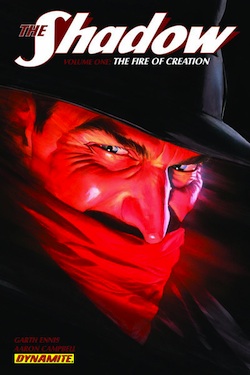I know the old year is over and I have to accept it. But certain pop-culture concepts are timeless, and even consciously cross eras. Late in 2012 I surveyed some exceptional modern comics that would not continue past the new year; around the same time several period-piece or updated-classic comics were just getting to the end of their beginning, or being given promising new starts. These aren’t ones that got away, but we need to be thankful that they’re there.
Suited for a swift backward glance are Dynamite Entertainment’s reboots of the famous yet not often widely-read Shadow and little-known but continuously produced Spider pulp franchises. Both characters from the 1930s, these are prototypical nocturnal vigilantes of the type that Batman made mainstream.
The Shadow is the character most cited as a direct precursor of and source for Batman, a figure who makes sure to terrorize his would-be opponents with his very presence and taps into primal fears of ephemeral demons and unseen warriors. The Shadow himself draws provenance from the East and its traditions, having been trained in Asia (like the Nolan movies’ Batman) and adapting martial-arts and meditation’s creed into a kind of mixed Freddy-esque stalker and ninja.
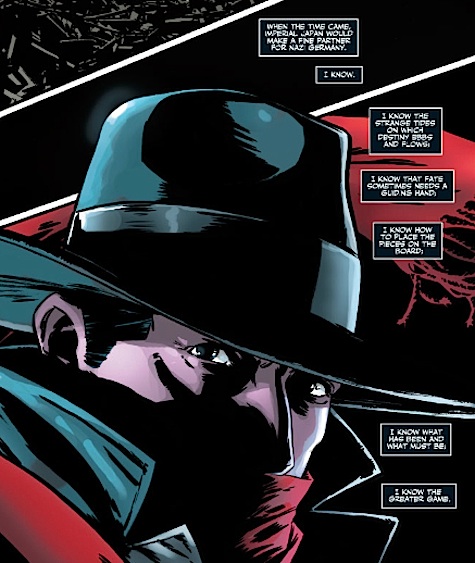
The first, six-issue arc of The Shadow’s latest comic reboot (though like The Spider he started in the prose pulps that preceded the comic form) was written by Garth Ennis, a specialist in tough-guy and military genres who was born to take on this mythos (and illustrated by Aaron Campbell, whose style brought a rough immediacy and classic atmosphere that was perfect for calling the book’s vintage essence forth into a contemporary context of retro chic and moral murk). Now available as a trade collection, The Fire of Creation follows the Shadow on a quest to intercept an unspecified miracle substance that could give the Axis the upper hand in the brewing world war. In his aristocratic guise as Lamont Cranston, he attaches himself to an officially semi-existent U.S. expedition to China.
Ennis is your man for writing a character who’s actually less of a dick in his guns-blazing spirit-of-vengeance persona than he is in his calculating, manipulative patrician role — but then, the murderous man in black has more clarity.
Cranston is posing as an ineffectual elite, and brings along Margo Lane to play a helpless damsel when she is in fact a steel-nerved wartime undercover agent and serene if possibly suicidal adventure-seeker; a fantastic characterization by Ennis of a period-believable woman who plays the social part and is much more than she seems.
Ennis is skilled at vicious scenarios with highly moral implications, and the too-little-known atrocities of Imperial Japan in pre-WWII China, and other realities of brutal humanity and neglectful authority in the creep and outbreak of global slaughter, are envisioned with a vividness that takes you right into the appalling action and makes you realize how close such things are to us always.
In a remarkable pivotal moment, the Shadow, echoing his eternal tagline, says that his teachers made him able to see the evil in men’s hearts by looking into his own, which gives a very new insight on the way this absolutist vigilante perceives the world in black-and-white—throughout the grueling odyssey of this story, there are all kinds of situations the Shadow doesn’t save people from, but the current of history is curved in ways that ensure survival of the many, revealing him as not so much the shadow as the light, knowing where the darkest places are and guiding the human race away from, and terribly near, and traumatically through them. And making The Fire of Creation a definitive summation and new perspective on the stoic and harshly benevolent ethic of pulp heroism.
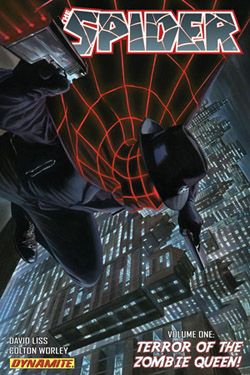
Defining it as he goes along, the Spider is still asking these questions in the present day. His book is written by David Liss, who delivered one of Marvel Comics’ freshest new series by reaching into a pulp past he invented for the company’s universe in Mystery Men two years ago, and drawn with creepy photo-collage style by Colton Worley for its first six issues, as if in a foggy, glaring crime-scene snapshot. The Spider, like CBS’s Person of Interest, realizes that the 2010s’ war-weary, politics-wary culture offers the same recipe of disillusionment and apprehension that 1940s noir did.
Richard Wentworth is a wealthy corporate scion who’s nevertheless done regular-guy service in Iraq and is back to dispense army-of-one justice on a city rife with questionable authorities and rogue superpsychos. The series is shot through with biblical conflicts — from Wentworth’s fraught relationship with his scumbag industrialist dad to his tension with the woman he loves and left, still feeling strongly for him but married to the police chief who wants his alter-ego off the streets. The first arc, Terror of the Zombie Queen, is out as a trade collection January 30, and pits him against an outbreak of dangerous, sleepwalking citizens as two master criminals try to enthrall a city with a neurotoxin that turns out to be from a most disillusioning source.
The Spider’s self-interrogating narration is like an emerging personal Constitution or modern Art of War, as at the point where he controls a murderous urge and reflects on how “giving in” to his hostility would be “giving up” on his dispassionate mission to keep the city safe. Like many pulp heroes he draws on a network of under-the-radar experts — those with subcultural connections, those with scientific lab equipment to analyze samples and synthesis antidotes — and we see a kind of alternate civilization emerging in the collapse of the conventional one. No one explores this model with more imagination than Liss, and in a harsh, irresistible saga we thrill to see the Spider overcome both his bizarre and his all-too-believable opponents, and wonder how he, like our precariously contradictory system, will ultimately fare with his potential worst enemy, himself.
Two comics ideally suited to being new-to-you if you haven’t been following them were the late-year one-shots of Hellboy creator Mike Mignola’s characters Baltimore and Lobster Johnson, both the subjects of ongoing intermittent miniseries and one-offs.
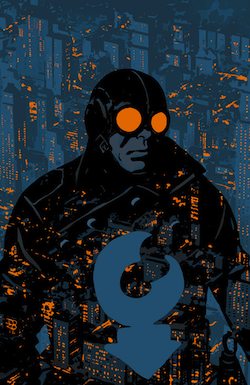
Co-written with John Arcudi and drawn in hardboiled woodcut form by Tonci Zonjic, Johnson relates to the characters considered above by being both the quintessence of the pulp avenger and the kind of workaday vigilante who would exist in a real world crowded by such personalities; a kind of merciless security-guard of the night. In contrast Lord Henry Baltimore (created and written with Christopher Golden) belongs to an earlier era of swashbuckling adventure, brought miserably to a premature end in a universe where World War I results in a rustic apocalypse. The conflict has released literal and metaphorical floods of evil, spreading a real-life plague and awakening a growing global horde of vampires.
In Caput Mortuum, Lobster Johnson (a goggled bruiser who brands a vengeful lobster’s-claw symbol on deserving perps’ foreheads, don’t ask me) appears in a self-contained tale perfect for unacquainted readers, fighting off a novel biological-warfare plot by Nazi sleeper agents. Unlike Baltimore, Lobster is part of the Hellboy timeline so supernatural threats are never far from the surface, but this mad-science plot showed the unique positioning of this particular neo-pulp character, patrolling the eerily narrow space and perhaps sadly short interval between primeval terrors of superstitious antiquity and barbarism brought on by rampant technological advance.
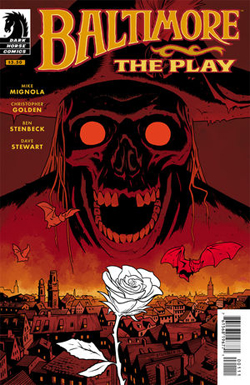
Lord Baltimore navigates a reality that has already fallen through that rift, with “The War to End All Wars” having instead probably ended the world; a not-implausible vision even without the vampires, as the influenza epidemic got transported worldwide with troop ships and the last old-fashioned bloodbath was prosecuted with the first mass-killing machinery. Baltimore is a bereft noble sworn to retribution against the vampire lord (hmmm) who massacred his family, and an incidental hero when other needy survivors appear on the path between him and his vendetta. But the one-shot The Play was in its way as placid as Caput Mortuum was frenzied, a good place for unfamiliar fans to stop in, especially since the hero himself rides past most of the story.
Illustrator Ben Stenbeck and color-artist Dave Stewart show the shadows of a grand, emptying Europe, conveying the stillness, as shallow yet impenetrable as a hastily dug grave, with such presence they could have ground their dark inks and gray pigments from black soil and gloomy sky itself. But in the spaces no one would brave or bother to look in, the drama of the comic’s title opens out; a weird scenario, in a bombed-out theatre, of a show which goes on even if life does not. Without revealing too much, I can mention that the story refreshingly looks in on the relatively benign spirits that might be roaming the earth in a world where vampires and krakens were also commonplace (quieter territory of fiction and calmer corners of life indeed often overlooked in adventure lit and real-world struggle, like Baltimore’s offstage pursuit of his nemesis past this creepy, tender scene it frames). The contrasts between a horrific stage-set and an ethereal, delicate tale of doomed love makes for an operatic and unusual drama as satisfying as some graphic novels many times this single periodical’s length.
The past will never be the same, and comics like these give hope that the form has a rich future whatever direction it looks in.
Adam McGovern’s dad taught comics to college classes and served as a project manager in the U.S. government’s UFO-investigating operation in the 1950s; the rest is made up. There is material proof, however, that Adam has written comicbooks for Image (The Next issue Project), Trip City.com, the acclaimed indie broadsheet POOD, and GG Studios, blogs regularly for HiLoBrow.com and ComicCritique and posts at his own risk on the recently launched Fanchild. He lectures on pop culture in forums like The NY Comics & Picture-story Symposium and interviewed time-traveling author Glen Gold at the back of his novel Sunnyside (and at this link). Adam proofreads graphic novels for First Second, has official dabblings in produced plays, recorded songs and published poetry, and is available for commitment ceremonies and intergalactic resistance movements. His future self will be back to correct egregious typos and word substitutions in this bio any minute now. And then he’ll kill Hitler, he promises.










